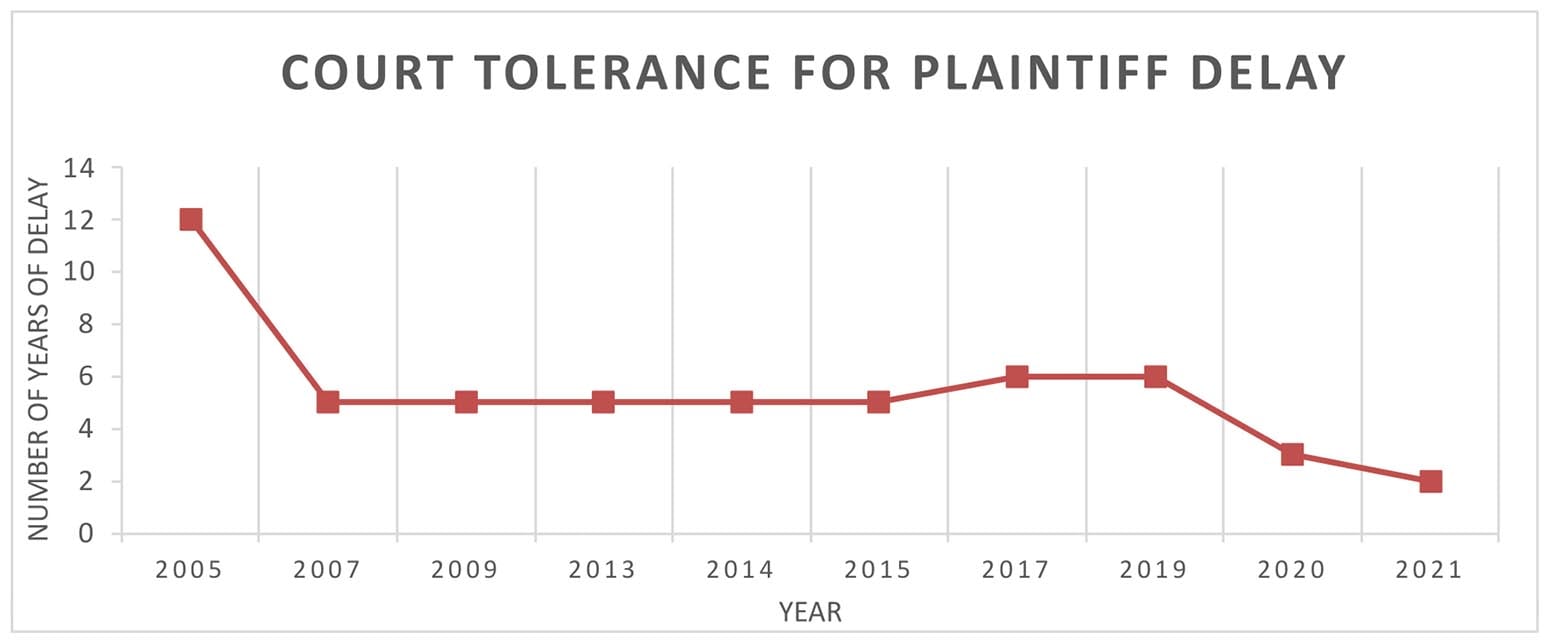
The time has come
A trend appears to be emerging of a reduced tolerance by the judiciary for plaintiffs who delay in prosecuting their claims. Eoin Pentony and Edward Murray assess the pitfalls of ‘stalling the ball’.
In the normal course of litigation, the parties to a case exchange pleadings to either advance or defend against a plaintiff’s claim – like the back-and-forth of the ball between players in a tennis match, until the claim is settled or the pleadings are closed and the case is ready for hearing.
There is a recent trend in some types of litigation (including civil and commercial litigation) in which the courts are becoming less tolerant of plaintiffs who fail and/or delay in progressing their claims. Multiple cases from 2021 indicate that, if a plaintiff engages in delay and/or does not progress their claim for two years or more, the courts are amenable to dismissing the proceedings on grounds of such delay.
The power
Under order 122, rule 11 of the Rules of the Superior Courts 1986, a defendant can bring a motion to dismiss the proceedings for delay – for want of prosecution – where a plaintiff fails for a period of two years to progress matters by continuing to exchange pleadings or taking steps in the proceedings. The courts also have an inherent jurisdiction to dismiss proceedings for delay at their own discretion.
Order 122 states: “In any cause or matter in which there has been no proceeding for one year from the last proceeding had, the party who desires to proceed shall give a month’s notice to the other party of his intention to proceed. In any cause or matter in which there has been no proceeding for two years from the last proceeding had, the defendant may apply to the court to dismiss the same for want of prosecution, and on the hearing of such application the court may order the cause or matter to be dismissed accordingly [emphasis added] or may make such order and on such terms as to the court may seem just.
A motion or summons on which no order has been made shall not, but notice of trial although countermanded shall, be deemed a proceeding within this rule.”
The test
The seminal case on this issue of dismissing proceedings for delay (and the one that is followed by all courts by way of precedent) is Primor Plc v Stokes Kennedy Crowley, a 1996 decision in which the Supreme Court established the three-step test:
- The court should consider whether the delay in question is inordinate,
- If the delay is inordinate, then the court should consider whether the inordinate delay is inexcusable,
- If the delay is both inordinate and inexcusable, the court should then consider whether the balance of justice favours the dismissal of the proceedings.
The Primor test establishes that delay, in itself, is not sufficient to dismiss proceedings. A defendant must also establish that the delay is inordinate, inexcusable, and that the balance of justice favours the dismissal of the proceedings.
Despite the possibility of a defendant bringing a motion under order 122 to dismiss proceedings for delay of two years or more, historically (pre-2015), the courts required a larger passage of time to pass before it would consider dismissing proceedings for delay.
In some cases, in addition to the Primor test, the courts also sought evidence on whether the delay prejudiced the defendant. This created an additional bar for the defendant to reach and, unintentionally, created a sedentary plaintiff-favoured court environment.
In 2005, in Hughes v Duffy, a case that concerned an application for restriction of a director pursuant to section 150 of the Companies Act 1990, Ms Justice Finlay Geoghegan in the High Court considered a delay of nearly 12 years.
The judge took the view that the delay was inordinate and inexcusable, and was solely that of the plaintiff, stating: “At the date of issue of this motion, a period in excess of 12 years had expired since the commencement of the winding-up and a period in excess of eight years from the last contact between the liquidator and either of the respondents.” Ms Justice Finlay Geoghegan dismissed the proceedings.
In 2009, in Mannion v Bergin and Bradley & Ors, Mr Justice Hedigan in the High Court considered a delay of nearly five years for proceedings that concerned a claim of negligence. In applying the Primor test and in allowing the application, the court granted the order to dismiss the proceedings “on the grounds of inordinate and inexcusable delay, and on the basis that the balance of justice including the right of the defendants’ to a trial of the case within a reasonable time, requires it”. In this case, a delay of five years was sufficient to cause the proceedings to be dismissed.
In 2014, in Nolan v Chadwick, Mr Justice Keane in the High Court considered an application to dismiss proceedings for a delay of five years. The court concluded that the plaintiff’s delay in progressing the proceedings was both inordinate and inexcusable. However, in circumstances where there was no specific prejudice against defendants, the balance of justice favoured permitting the proceedings to continue, and the court rejected the application to dismiss the proceedings. Accordingly, the court rejected the defendant’s motion.
The turning point
There was a notable shift in the courts from 2015. In Minister for Justice, Equality and Law Reform v Gorman, Mr Justice Noonan (High Court) granted an application to dismiss proceedings for a delay of nearly five years, in circumstances where over 11 years had passed since the event giving rise to the cause of action. The proceedings related to a claim by the plaintiff in respect of assault, battery, and false imprisonment.
The matter was appealed to the Court of Appeal and, in refusing the appeal, Ms Justice Irvine (as she was then) stated that “in dismissing this plaintiff’s claim, the decision of the High Court ha[s] the effect of ending his constitutional right of access to the courts. However, this is not an unqualified right and is one which must be balanced against the right of the defendants to protect their good name.”
This decision marks a change in judicial thinking from focusing on protecting the plaintiff’s right of access to justice, towards a more balanced approach of the plaintiff’s right of access to justice against the defendant’s right to protect their good name.
From 2015, we also see a general trend in the reduction of the passage of time that the courts will tolerate for a plaintiff to progress their proceedings. This noticeably reduced tolerance culminated in 2021 with (a) the courts noticeably counting the passage of time as a matter of months rather than years, and (b) not tolerating a failure to progress proceedings in some cases for two years (that is, 24 months).
In 2021, in Gibbons v N6 (Construction) Limited and Galway County Council, Ms Justice Butler in the High Court considered an application to dismiss proceedings on foot of a three-year delay. Applying the Primor test and highlighting “the court’s obligation to ensure the efficient conduct of litigation”, the court dismissed the proceedings.
Kehoe & Anor v Promontoria (Aran) Ltd and Anor, is a recent case where Mr Justice Twomey in the High Court considered an application to strike out the plaintiff’s proceedings for delay of three years and to vacate a lis pendens. Applying the Primor test, the court found the delay of 37 months was inordinate and, as “neither of [the] explanations sufficiently excuse the delay of 37 months”, the delay was found to be inexcusable.
As the plaintiffs put forward no evidence to suggest any defect in the deed of mortgage or other security documents, the court found that the balance of justice lay in favour of striking out the proceedings. This decision is currently under appeal.
The High Court, in Diamrem Limited v Clare Co Council, considered a claim seeking damages for, among other things, misfeasance of public office. Mr Justice Twomey considered a delay of 22 months and, in granting the motion, cited an earlier Supreme Court judgment stating that there is “sea-change in the indulgent attitude of the courts to litigants who are guilty of delay in the prosecution of their proceedings”.
In Cabot Financial (Ireland) Ltd v Heffernan & Ors, Mr Justice Meenan considered an application by the defendants to dismiss summary proceedings of €2.5 million against the defendant/borrowers on the basis of a delay of between 12 and 17 years. In applying the Primor test, and in circumstances where the defendant/borrower did not acquiesce to the delay, and taking account of the age and health of the defendant, the court dismissed the summary judgment claim.
Our analyses of applications seeking to strike out proceedings for delay from 2004 to 2021 observe a general trend by the courts for a reduced tolerance of plaintiffs who fail to progress their proceedings expeditiously. This reduction in judicial tolerance is illustrated in the graph (below).

The effect
With the judiciary’s (arguably) increased intolerance for plaintiff delay, combined with the two-year threshold highlighted in the 2021 cases mentioned above, motions to dismiss proceedings under order 122 will potentially become more widely utilised by legal practitioners.
From our review of the case law in the area of delay, a trend appears to be emerging where the judiciary seems to be less tolerant towards plaintiffs engaging in delay to progress their claim. This trend culminated in 2021, where three decisions indicate that a two-year delay in progressing proceedings is sufficient grounds for bringing an application for delay under order 122.
The increased popularity of motions under order 122, or even the increased awareness and/or threat of using this order, should (in theory) result in litigating parties moving claims more expediently through the courts system. This, in turn (or at least in theory), should result in a reduction in the presence of historic proceedings, smaller court lists, and overall lower legal fees for litigating parties. In light of the foregoing, the lesson to all litigating parties is that time matters – avoid delay!
Look it up
CASES
- Cabot Financial (Ireland) Ltd v Heffernan & Ors [2021] IEHC 823
- Diamrem Limited v Clare Co Council [2021] IEHC 408
- Gibbons v N6 (Construction) Limited and Galway County Council [2021] IEHC 138
- Minister for Justice, Equality and Law Reform v Gorman [2010] IEHC 210; [2015] IECA 41
- Hughes v Duffy & Anor [2005] IEHC 145
- Kehoe & Anor v Promontoria (Aran) Ltd and Anor [2021] IEHC 573
- Mannion v Bergin and Bradley & Ors p/a O’Connor and Bergin Solicitors [2009] IEHC 165
- Nolan v Chadwicks Limited [2014] IEHC 542
- Primor Plc v Stokes Kennedy Crowley [1996] 2 IR 459
LEGISLATION
- Order 122, rule 11 of the Rules of the Superior Courts
LITERATURE
- Eoin Pentony and Edward Murray (2022), ‘Time’s up for delay’, Commercial Law Practitioner, 29[1] 9-13
Read and print a PDF of this article here.